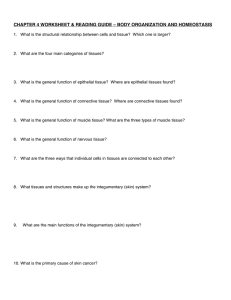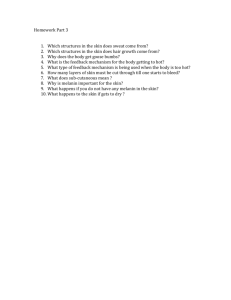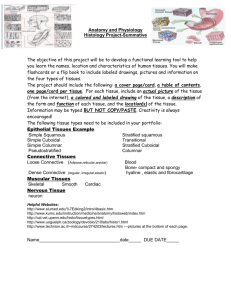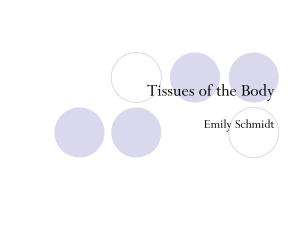Anatomy - Histology Why study this module ?
advertisement
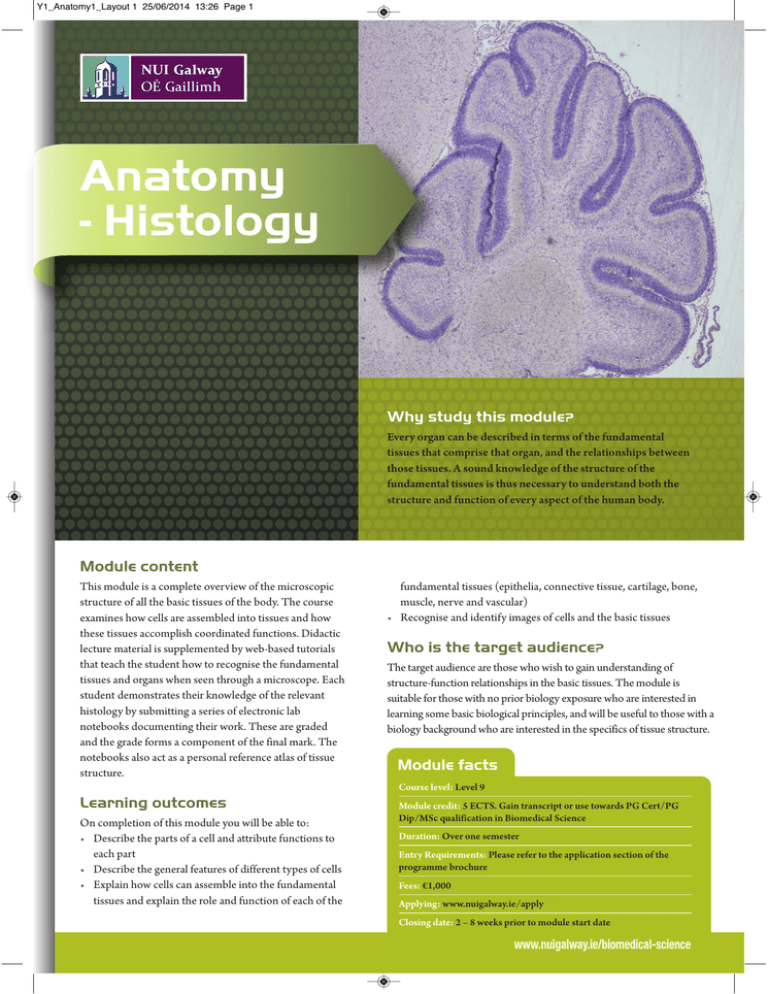
Y1_Anatomy1_Layout 1 25/06/2014 13:26 Page 1 Anatomy - Histology Why study this module? Every organ can be described in terms of the fundamental tissues that comprise that organ, and the relationships between those tissues. A sound knowledge of the structure of the fundamental tissues is thus necessary to understand both the structure and function of every aspect of the human body. Module content This module is a complete overview of the microscopic structure of all the basic tissues of the body. The course examines how cells are assembled into tissues and how these tissues accomplish coordinated functions. Didactic lecture material is supplemented by web-based tutorials that teach the student how to recognise the fundamental tissues and organs when seen through a microscope. Each student demonstrates their knowledge of the relevant histology by submitting a series of electronic lab notebooks documenting their work. These are graded and the grade forms a component of the final mark. The notebooks also act as a personal reference atlas of tissue structure. fundamental tissues (epithelia, connective tissue, cartilage, bone, muscle, nerve and vascular) • Recognise and identify images of cells and the basic tissues Who is the target audience? The target audience are those who wish to gain understanding of structure-function relationships in the basic tissues. The module is suitable for those with no prior biology exposure who are interested in learning some basic biological principles, and will be useful to those with a biology background who are interested in the specifics of tissue structure. Module facts Course level: Level 9 Learning outcomes On completion of this module you will be able to: • Describe the parts of a cell and attribute functions to each part • Describe the general features of different types of cells • Explain how cells can assemble into the fundamental tissues and explain the role and function of each of the Module credit: 5 ECTS. Gain transcript or use towards PG Cert/PG Dip/MSc qualification in Biomedical Science Duration: Over one semester Entry Requirements: Please refer to the application section of the programme brochure Fees: €1,000 Applying: www.nuigalway.ie/apply Closing date: 2 – 8 weeks prior to module start date Y1_Anatomy1_Layout 1 25/06/2014 13:26 Page 2 Student testimonial Module topics Introduction to cells and tissues • Classification of epithelia • Additional features of epithelia • Epithelia derivatives • Cell - cell interactions and epithelia Cell - matrix interactions and the general connective tissues • Connective tissue structure • Ground substance • Extracellular fibres • Connective tissue cells • Loose connective tissue • Dense irregular connective tissue • Dense regular connective tissue • Adipose tissue Cartilage • Structure of cartilage • Fibrocartilage - intervertebral disc • Hyaline cartilage Bone • Bone structure • Cellular constituents • Functional organisation - the osteon • Remodelling • Fracture repair Muscle • Skeletal muscle structure • Cardiac muscle structure • Myofibril structure • Sarcomere structure & function • Smooth muscle • Hypertrophy, hyperplasia, and atrophy Nerve • The nervous system • Neurons & neuronal function • Nerve conduction • Myelination & salutatory conduction Jennifer Mulholland Current position: Site Microbiologist in an In Vitro Diagnostics Company. Position held when completing Masters: Production Biochemist in an In Vitro Diagnostics Company. “I found the module on Histology particularly stimulating and informative. The method through which the practicals were done i.e. an online microscope, was in particular what I found most enlightening and engaging. The software used was of a very high standard and allowed for in depth analysis of histological samples. I found myself exploring things beyond those prescribed in the practical instructions, as the exceptional standard of the software used indulged my inquisitive nature. Areas of study included the cardiovascular system, epithelium, nerve and bone, cartilage, the respiratory tract, the GI tract, muscle and bone. In my opinion, to work in any biological based company or a company which produces materials that act on biological systems (e.g. pharmaceutical, medical devices, clinical studies etc.) it is of immense benefit to understand biological systems from as many aspects as possible, including histologically. In my area of employment, deeper knowledge of the respiratory tract, epithelium, cardiovascular system and GI tract have been of great benefit. I work in an area associated with in vitro diagnostics of diseases such as viral respiratory infections, autoimmune diseases, diabetes, cardiovascular failure, anemia, liver failure etc. Having an in depth knowledge of the systems which these diseases affect has deepened my understanding of the production, QC and problem troubleshooting of these products. Firstly, I would recommend this module to anyone who has even a passing interest in histology. I feel this module is so informative and interactive that anyone who takes it will be surprised at how much they learn, and how much they actually enjoy it. Secondly, I would recommend this course for anyone who intends to work, or who already works, in a position which requires in depth problem solving. To truly be efficient at this it is essential to know how the product works from the following (but not limited to) areas chemical, pharmacological, biochemical, cellular and histological. As such, this is why I would recommend the module in Histology.” Cardiovascular system • The Heart • Histological structure of the heart • Blood vascular system • Arteries & veins • Capillary structure • Endothelial cells • Atherosclerosis and endothelial damage The lymphatic system Module Director Dr. Brendan Wilkins Brendan received his BSc (Hons) in Biochemistry from NUI Galway. He completed his Ph.D. in Cell Biology at Baylor College of Medicine in Houston, Texas, USA where his dissertation research was on proteins that interact with sperm during fertilization. After completing a postdoctoral fellowship in medical education, he returned to Ireland. Brendan was involved in the early stages in the establishment of the National Centre for Biomedical Engineering Science (NCBES) and the full-time MSc Biomedical Science program. His research interests now include factors that determine cell phenotype in the cardiovascular system, and 3D cell culture and cell patterning. Contact details: Email: brendan.wilkins@nuigalway.ie Tel: +353 (0)91 492 287 www.nuigalway.ie/anatomy/fabiobio.html

